We stood in the ruined fort looking down at the sea. Each one of us was exhausted from months of excavation, but feeling rejuvenated by our climb to the top of Castle Island.
From our vantage point we could watch the ocean churn amongst the reefs lying out beyond the small barrier islands. Far beneath us the water surged amongst jagged rocks, swirling into dark eddies and casting foam high into the air. It was tempting to lean out as far as you could, but the limestone cliffs were weak and crumbling where we stood beside the four-hundred year old walls.
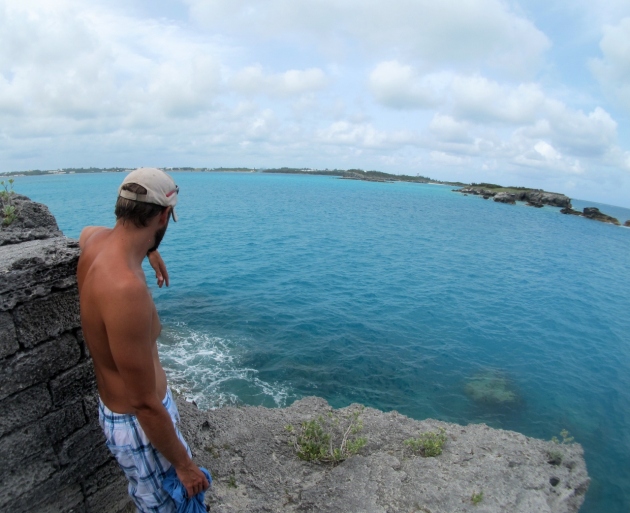
Doug looks over the edge of the Sea Battery. The cliffs were crumbling, and he felt most comfortable standing back a ways. – Photo by Veronica Morriss © 2012 the Warwick Project

The water surged amongst jagged rocks, swirling into dark eddies and casting foam high into the air. – Photo by Douglas Inglis © 2012 the Warwick Project
Castle Island defended the early colony of Bermuda. A natural battlement, it guarded Castle Roads, the only navigable channel between the reefs and rocky outcrops that surrounded Bermuda’s primary harbour and the King’s Anchorage. The island is home to three small forts. It was one-half of a sea gate – the other half was Fort Southampton on a small island one thousand feet to the east. If Castle Harbour was ever threatened by sea, the two forts could raise a chain between them, blocking the channel – a crude portcullis of sorts.

Director Piotr Bojakowski points to Fort South Hampton, across Castle Roads. If Castle Harbour was ever threatened by sea, the two forts could raise a chain between the islands.

An overview of the Kings Castle and the sea battery. Veronica exploring. – Photo by Douglas Inglis © 2012 the Warwick Project
The Kings Castle stands at the eastern apex of Castle Island. Started in 1612, it is the oldest standing English fortification in the new world and Bermuda’s oldest extant stone structure. It was improved in the 1620s by Governor Nathaniel Butler as part of his great building campaign, and it is now part of a UNESCO world heritage site.
It is easy to reach the fort by boat. Many day cruisers come and anchor between the network of tiny islands, as we did. We just leapt over the side of the boat and swam into a small sandy cove which had collected a fair amount of seaglass. Once you climb onto the rocks you can follow a rudimentary path up the hillside. Overgrown with leaves and cactus, it leads you past degraded outbuildings to the top of the cliff, where you have an extraordinary view the ocean and roofless “Captains House”. Erected by Butler in 1621, it is now the oldest standing English house in the New World.
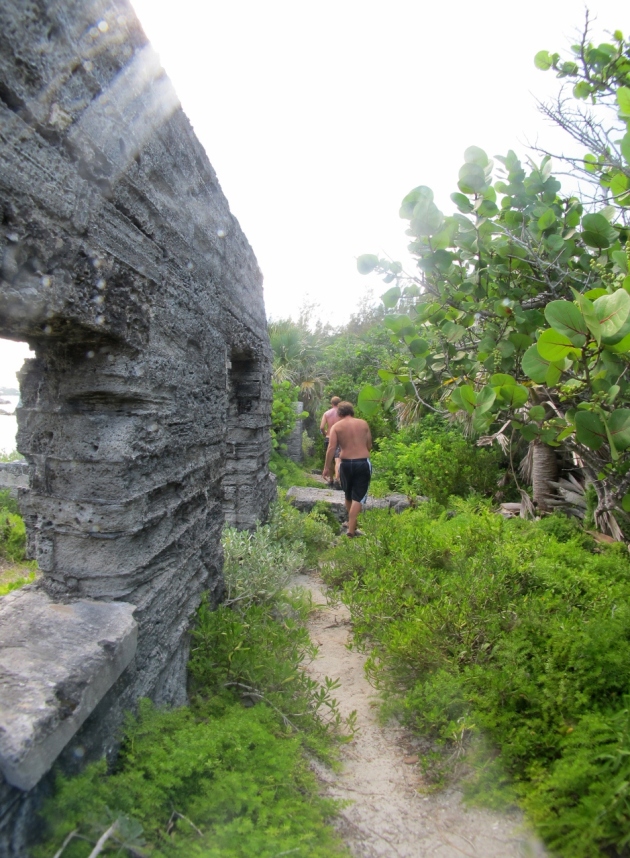
The thorny trail in front of the ruined outbuildings. – Photo by Veronica Morriss © 2012 the Warwick Project

The crumbling walls of the Captains House. Erected by Butler in 1621, it is now the oldest standing English house in the New World. – Photo by Douglas Inglis © 2012 the Warwick Project
Standing there, it was hard to imagine how isolating this place would have been for the soldiers and conscripts belonging to the small Bermudian garrison. It is easy for day travelers like us to come and go with the weather. Four hundred years ago, however, this far-flung outpost would have had little contact from St. Georges, and no relief from the tempestuous island storms. It would have been a cold and miserable assignment much of the winter.
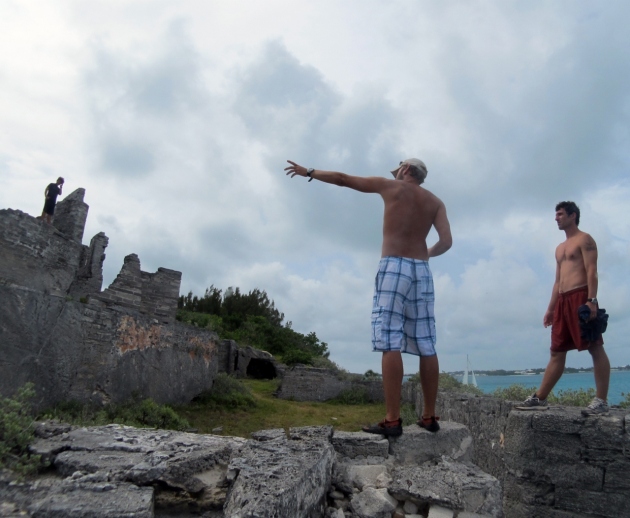
Assistant Director Doug Inglis and Project Director Piotr Bojakowski discussing the Kings Castle defenses – Photo by Veronica Morriss © 2012 the Warwick Project

Josh and Maureen look over the edge of Castle Island – Photo by Douglas Inglis © 2012 the Warwick Project
The only serious action the Kings Castle witnessed was just after its inception. Although the Spanish had know of Bermuda for some time (its was named after famed navigator Juan de Bermúdez), their fleets largely avoided the “Isle of Devils”. They took notice however when English entrepreneurs decided to form a colony on the small mid-Atlantic steppingstone. The Spanish sent a reconnaissance mission in 1614. It was repulsed by two rounds of cannon fire from the Kings Castle. The Spanish fell back, not knowing that the under-armed battery only had one shot left! Desperately short of ordnance, the island was defended by a cannon that had been salvaged from the 1609 wreck of Sea Venture.
The island defenses would remain precariously thin until the arrival of Governor Nathaniel Butler and the unexpected demise of Warwick, the ship that brought him to Bermuda. (To learn more about the shipwreck and 2012 excavation, click here.) Salvers were able to raise eight cannons which were used to bolster the island’s defenses.
If you want to learn more about Bermuda’s Historic Forts, check out a copy of “Bermuda Forts, 1612 – 1957” by Dr. Edward C. Harris. It is an incredible book, and a great guide to the Island!
And if you are still interested, there are two more forts on this island which I will write about soon. Until then, thanks for reading!
-Douglas Inglis
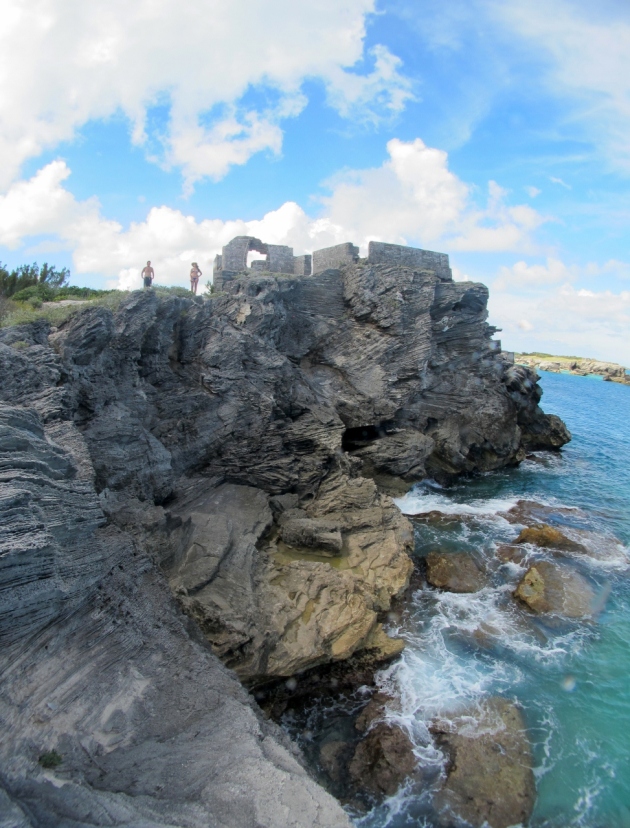

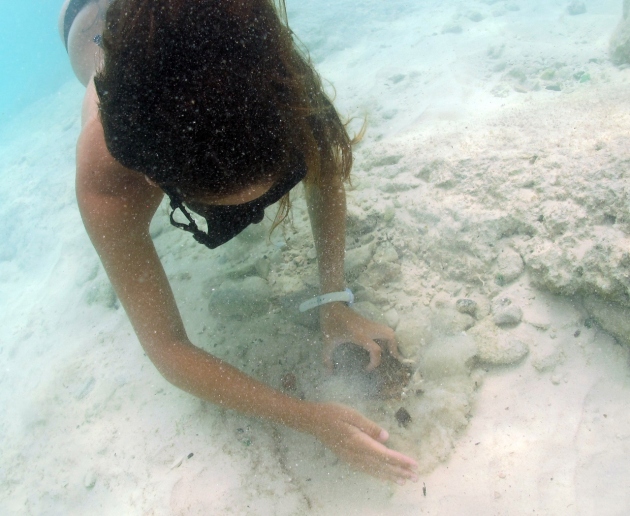





Looking forward to more….
I am glad to hear it! I find the history of Bermuda’s forts really intriguing. So much was invested in defenses that saw little use.
Reblogged this on Warwick, 1619: Shipwreck Excavation.
Good to see you posting again!